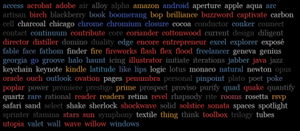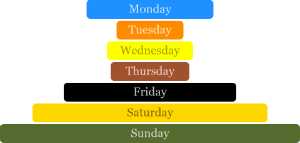Atoms
Notes
This representation of 118 elements allows you to create your own charts of atoms, from traditional periodic tables to plots comparing the abundance of the elements in the Earth and the sea
The bundles of protons and neutrons we call nuclides tend to attract clouds of electrons; because protons are positively charged and electrons are equally negatively charged, the number of electrons in the cloud tends to equal the number of protons in the nuclide. We call this combination of nuclide and electron cloud an atom.
When we think about atoms, we tend not to worry about how many neutrons are in the nucleus. It's the number of protons that's crucial, because that's what determines the number of electrons, which determines the chemical properties of the atom. We don't usually worry, for example, whether an oxygen atom has 8, 9 or 10 neutrons; we focus instead on the fact that it has 8 protons, which means that it has 8 electrons, which means that it lacks 2 electons to complete its outer shell, which means that it readily combines with 2 hydrogen atoms to form a water molecule. So when we show tables of atoms, we group together all atoms with 8 protons, regardless of the number of neutrons, into what we call the element oxygen.
The standard periodic table of these elements is familiar to us all, and there are some excellent interactive periodic tables on the web (see Michael Dayah's splendid Ptable or the Royal Society of Chemistry's periodic table; be sure to check out all the tabs). There are also many interesting alternatives to the standard layout (see this Wikipedia gallery for a few colourful examples).
Rather than attempt to follow these class acts, this page allows you to create your own charts of atoms. After all, the standard periodic table simply lays out the elements according to the number of electron shells and the numbers of electrons in the outer shells: hydrogen and helium, which each have only 1 shell, are at the top, while uranium and plutonium, which each have 7 shells of electrons, are at the bottom; sodium and potassium, which each have only 1 electron in the outer shell, are on the left, while neon and radon, which each have the full complement of electrons in the outer shell, are on the right.
Click on the buttons to the right of the chart to arrange the atoms according to different properties. Or click on the buttons below and to the left of the chart for complete control over how the atoms are arranged left to right and bottom to top, and click the buttons above the chart to change how they are coloured red through blue.
There are more than 16,000 different ways to arrange and colour the atoms. Watch the animations as you switch from one arrangement to another. For example, click backwards and forwards between the thermal conductivity and electrical conductivity buttons, and notice how the metals that are good conductors of heat are proprotionately good conductors of electricity, and the inert gases (helium, neon, argon, etc.) which do not conduct electricity at all are also poor conductors of heat. To plot the relationship between thermal and electrical conductivity precisely, click the THERM button below the chart and the ELEC button to the left; note how most of the elements are along a straight line, with a few semiconductors as outliers.
Subscribe now and I’ll let you know whenever I create a new visualization
It’ll only be every couple of months or so, I won’t let anyone else have your email address, and you can unsubscribe at any time
Thanks for subscribing!
Check your inbox for an email to confirm your subscription
Oh no, something went wrong, and I was unable to subscribe you!
Please refresh your browser and try again
More
This is one of a series of visualizations of what things are made of, from elementary particles to organic molecules…
Atoms – this page
…check back soon for the next in the series
Latest things made thinkable
Sources
Wikipedia – Atomic radii of the elements
Wikipedia – Electrical resistivities of the elements – (electrical conductivity at room temperature / S/m) = 1 / (electrical resistivity at 293K (or closest available) / Ωm) – the value of carbon is that of graphite rather than diamond
Wikipedia – Thermal conductivities of the elements – the value of carbon is that of graphite rather than diamond
Wikipedia – Abundances of the elements – (abundance of elements in sea water / mg/kg) = (CRC Handbook mass per volume fraction / kg/L) / (average density at the surface 1025 / kg/m³) * (10³ L/m³) * (106 mg/kg)
Date
First published 24 November 2013












Comments
Click here to leave a comment
Thanks for your comment!
I’ll check it and put it live as soon as I can
Oh no, something went wrong, and I was unable to post your comment!
Please refresh your browser and try again